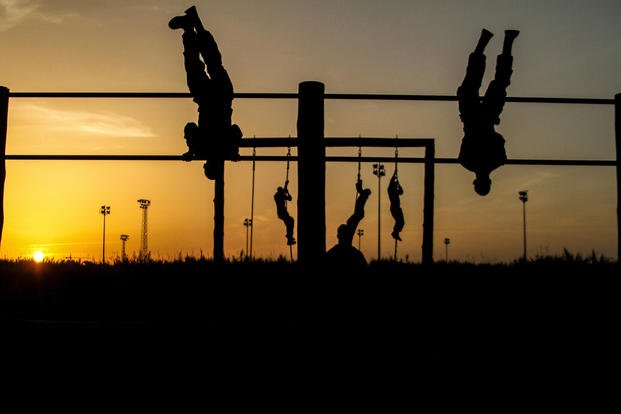Here are the articles that got 2018 moving in the right direction, made the most impact and offered ideas for people to use in their own training plans. Check out the best articles of 2018 and see whether you can take what you learned this year and apply it to 2019. Let's get after those goals.
1. Crawling into 2018. We started off the year crawling into 2018. The first article in January 2018 was a piece about crawling as a progression from planking and other core exercises but also as a fundamental movement pattern. We even started off the year with a quote from Jeff Nichols (former SEAL/exercise physiologist) from the Tactical Strength and Conditioning Conference: "If you think fundamental movement patterns are not important, try loosening the lug nuts of your car. Driving slowly, it may not be that noticeable but pick up speed, and you will better understand the need for proper movement."
2. Don't Just Train for the PT Test. When billets to enter programs in the military, special operations, and law enforcement are tight, the better you do physically on entry-level fitness exams, the more competitive you are. In some Journal of Athletic Training (National Athletic Trainers Association) studies, you can see how important a higher fitness level is to your performance in training and longevity in active duty. These studies took candidates' performance results on the entry fitness test and observed how they did in training, focusing on overall physical performance and injury statistics getting to and through training.
3. Who Needs a Reason to Train? We all do. Sometimes, we need concrete reasons why to train. We created a top 10 list of personal markers/bucket-list ideas that many find helpful in keeping the motivation to train. Check out the list for more ideas each year you train. It's a list of standards that hard-charging military, police, firefighters and equally tough civilians use as their benchmarks of fitness.
4. Special Ops Journey Is Competitive. The road to a Special Operations career is challenging every step of the way. This was one of the first posts in which we broke down the differences of Phase 1 of tactical fitness (Crush the PT test to get to the training), Phase 2 (Prepare specifically to get through the training), and Phase 3 (Operator fitness focused on mission readiness, maintenance, recovery and stress mitigation). Know your place along the journey and prepare properly.
5. Top 10 List -- Ready to Serve. You may think you are ready to serve because you turned 18 last month, but typically that is not the case. If you are thinking about the special operations pipelines, you need to take more time to prepare for all the challenges in front of you, because the assessment/selection program will find weaknesses you never knew you had. Join when you are ready -- not just because you can. There is a huge difference.
6. Dealing with Failure, Quitting -- Growing Stronger. In a world in which attrition rates are higher than graduation rates, many people do not complete challenging special-ops selection programs for countless reasons. There is only one way to deal with failure: Become stronger from it, or it will eat you alive. Keep the faith and keep moving forward. Check out the article for tips past this mental roadblock.
7. The Tactical Fitness Rules. Developing your physical abilities and mindset are required during the preparation phases of training for anything challenging, especially in the tactical professions. There are different rules, strategies and training methodologies you should understand before going down the tactical fitness pathway. Traditional athletic training is not that different, but you should be aware of subtleties exclusive to tactical training. See the article for "rules" that help describe the differences in training as well as mindset.
8. Tactical Fitness for Athletes over 40 has been a big hit with many active-duty troops and veterans who still like to get after their fitness pretty hard. But there are things you need to learn if you want to reduce the typical aches and pains of a life well-lived. Fitness over 40 and into your 50s was a popular article this year and led to an entire series of programs for Tactical Fitness 40+.
9. The Biggest Problems Confronting Tactical Athletes. In the world of Tactical Athletics, many mistakes are made by military members, police and firefighters. There are those who quit training after boot camp or the police/fire academies and start to gain weight and are injured on the job.
There are those who go hardcore every day with little to no recovery cycles and get injured training. And there are those who find the right balance of workouts to help with job performance, mobility, recovery, longevity and, probably most important, stress mitigation. This article offers advice to achieve that balance.
10. Proven Methods to Rebuilding the Fitness Habit. Finally, we all need to refocus our efforts from time to time. We can get out of a healthy habit very easily and build one of doing something else (or nothing) for a very long period. When you spend a long time not exercising, you build a habit of not exercising. To achieve a new exercise goal, you must deal with two habits: one that you must break and one that you must start. This article has a list aimed at helping you deal with that problem.
I hope 2019 is better than ever for you and your journey.
Stew Smith is a former Navy SEAL and fitness author certified as a Strength and Conditioning Specialist (CSCS) with the National Strength and Conditioning Association. Visit his Fitness eBook store if you’re looking to start a workout program to create a healthy lifestyle. Send your fitness questions to stew@stewsmith.com.
Want to Learn More About Military Life?
Whether you're thinking of joining the military, looking for fitness and basic training tips, or keeping up with military life and benefits, Military.com has you covered. Subscribe to Military.com to have military news, updates and resources delivered directly to your inbox.
















